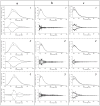Determination of enantiomeric compositions of analytes using novel fluorescent chiral molecular micelles and steady state fluorescence measurements
- PMID: 17985217
- PMCID: PMC2662355
- DOI: 10.1007/s10895-007-0268-z
Determination of enantiomeric compositions of analytes using novel fluorescent chiral molecular micelles and steady state fluorescence measurements
Abstract
Novel fluorescent chiral molecular micelles (FCMMs) were synthesized, characterized, and employed as chiral selectors for enantiomeric recognition of non-fluorescent chiral molecules using steady state fluorescence spectroscopy. The sensitivity of the fluorescence technique allowed for investigation of low concentrations of chiral selector (3.0 x 10(-5) M) and analyte (5.0 x 10(-6) M) to be used in these studies. The chiral interactions of glucose, tartaric acid, and serine in the presence of FCMMs poly(sodium N-undecanoyl-L-tryptophanate) [poly-L-SUW], poly(sodium N-undecanoyl-L-tyrosinate) [poly-L-SUY], and poly(sodium N-undecanoyl-L-phenylalininate) [poly-SUF] were based on diastereomeric complex formation. Poly-L-SUW had a significant fluorescence emission spectral difference as compared to poly-L-SUY and poly-L-SUF for the enantiomeric recognition of glucose, tartaric acid, and serine. Studies with the hydrophobic molecule alpha-pinene suggested that poly-L-SUY and poly-L-SUF had better chiral discrimination ability for hydrophobic analytes as compared to hydrophilic analytes. Partial-least-squares regression modeling (PLS-1) was used to correlate changes in the fluorescence emission spectra of poly-L-SUW due to varying enantiomeric compositions of glucose, tartaric acid, and serine for a set of calibration samples. Validation of the calibration regression models was determined by use of a set of independently prepared samples of the same concentration of chiral selector and analyte with varying enantiomeric composition. Prediction ability was evaluated by use of the root-mean-square percent relative error (RMS%RE) and was found to range from 2.04 to 4.06%.
Figures






Similar articles
-
The use of poly(sodium N-undecanoyl-L-leucylvalinate), poly(sodium N-undecanoyl-L-leucinate) and poly(sodium N-undecanoyl-L-valinate) surfactants as chiral selectors for determination of enantiomeric composition of samples by multivariate regression modeling of fluorescence spectral data.J Fluoresc. 2006 Sep;16(5):659-70. doi: 10.1007/s10895-006-0104-x. Epub 2006 Jul 7. J Fluoresc. 2006. PMID: 16826460
-
A versatile chiral selector for determination of enantiomeric composition of fluorescent and nonfluorescent chiral molecules using steady-state fluorescence spectroscopy.Chirality. 2009 Feb;21(2):305-15. doi: 10.1002/chir.20580. Chirality. 2009. PMID: 18512253
-
Chiral recognition of amino acids by use of a fluorescent resorcinarene.Appl Spectrosc. 2008 May;62(5):476-80. doi: 10.1366/000370208784344514. Appl Spectrosc. 2008. PMID: 18498687 Free PMC article.
-
Selectivity in capillary electrophoresis in the presence of micelles, chiral selectors and non-aqueous media.J Chromatogr A. 1997 Dec 19;792(1-2):13-35. doi: 10.1016/s0021-9673(97)00728-0. J Chromatogr A. 1997. PMID: 9463904 Review.
-
Recognition Mechanisms of Chiral Selectors: An Overview.Methods Mol Biol. 2019;1985:1-33. doi: 10.1007/978-1-4939-9438-0_1. Methods Mol Biol. 2019. PMID: 31069726 Review.
References
-
- Hacksell U, Ahlenius S. Chirality in drug research design. Trends Biotechnol. 1993;11(3):73–74. - PubMed
-
- Witte DT. Development and registration of chiral drugs. Pharm World Sci. 1993;15(1):10–16. - PubMed
-
- Subramanian G. Chiral separation techniques: a practical approach. 2. Wiley-VCH; Weinheim: 2001.
-
- Agranat I, Caner H, Caldwell J. Putting chirality to work: the strategy of chiral switches. Nat Rev Drug Discov. 2002;1(10):753–768. - PubMed
-
- US Food and Drug Administration. Development of new stereoisomeric drugs [policy statement] 1992;22:249.
Publication types
MeSH terms
Substances
Grants and funding
LinkOut - more resources
Full Text Sources
Other Literature Sources

